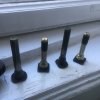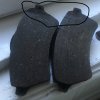Hey landys,
Nab questions.
I removed both front brakes (first time ever) and now I have doubts putting them back, as both sets are mixed together. I cannot remember which guide pin goes on top (the short one with plastic or the long one?).
Also I see brake pads have one of the edges bent. Again, does it matter which way I fit the pads as long as they fit correctly? (they probably go one way anyway).
Cheers!
Nab questions.
I removed both front brakes (first time ever) and now I have doubts putting them back, as both sets are mixed together. I cannot remember which guide pin goes on top (the short one with plastic or the long one?).
Also I see brake pads have one of the edges bent. Again, does it matter which way I fit the pads as long as they fit correctly? (they probably go one way anyway).
Cheers!
Attachments
Last edited:


